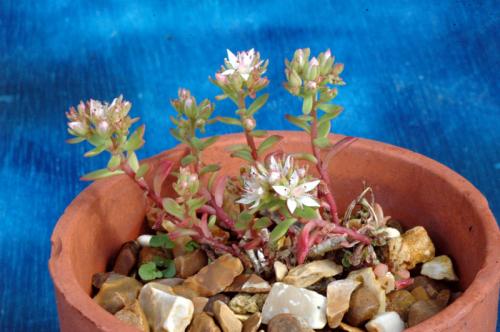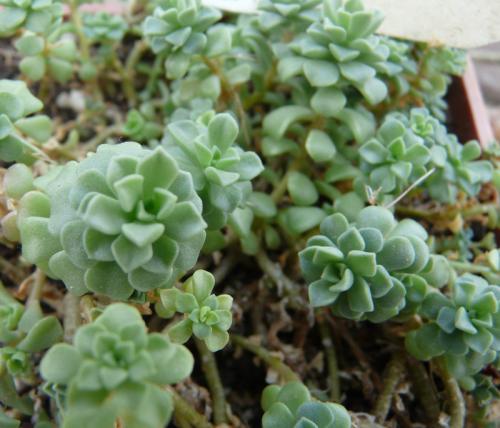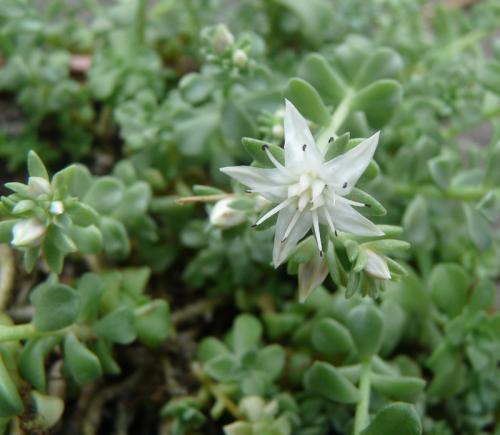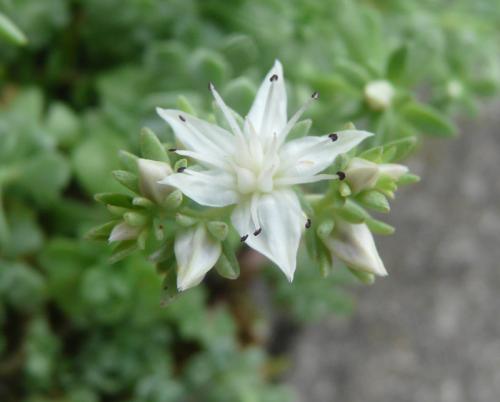COCKERELLII Britton, 1903
Synonyms :
Cockerellia cockerellii (Britton) A. Löve & D. Löve (1985)
Sedum puberulum S. Watson (1888)
Sedum wootonii Britton (1903)
Sedum griffithsii Rose, 1905 *
Sedum anomoiosepalum Fröderström (1936)
Type : Cockerell s.n., New Mexico, USA.
Etymology : Named for Theodore D.A. Cockerell (1866 – 1948), an American entomologist and systematic biologist who collected the type of S. cockerellii.
Distribution : S USA (New Mexico), N Mexico (Chihuahua) ; shallow soils preferably in shade, 1600 - 3200 m.
Description (by 't Hart & Bleij in IHSP, 2003) :
Glabrous small perennial tufted herbs with short rootstocks bearing tiny rosettes.
Leaves alternate, obovate or oblong-spatulate, broadly rounded to obtuse, flat, spurred, sessile, 3 - 5,8 x 1,6 - 3,3 mm, papillose, sometimes glaucous, green or yellow-green.
Inflorescences : Flowering branches erect, 5,6 - 9,1 cm, sometimes papillose upwards, inflorescences cymes with 2 or 3 (-4) branches, bracts leaf-like but smaller, pedicels 1 - 3,5 mm.
FIowers 5-merous, sepals basally free, shortly spurred, unequal, lanceolate-linear or clavate-oblong, papillose, acute or obtuse, 4,7 - 11,9 x 1,4 - 2,6 mm, yellow-green to green, petals free, rarely slightly connate, lanceolate-elliptic, obtuse and with a minute mucronate appendage, white, streaked with pink, ± 7 mm, filaments white, anthers brown.
Cytology: 2n = 28, 30, 32, (34), 58, 64.
The synonymization of S. wootonii, which is based on a composite collection also embracing specimens of S. wrightii, follows Clausen (1975: 198).
* The synonymization of S. griffithsii - in contradiction to 't Hart, IHSP, 2003 - follows Uhl, Rhodora 74, 1972, and Rhodora 87, 1985, and Ray Stephenson, Sedum, Cultivated Stonecrops, 1994.
Ray Stephenson (Sedum, Cultivated Stonecrops, 1994, p 248) :
In their second season, tiny rosettes of Sedum cockerellii elongate from a fleshy rootstock to about 18 cm (7 in). Scattered, flat, spathulate to lanceolate, spurred, smooth leaves are light green. In autumn, cymes of white, campanulate flowers are produced.
Habitat : This is a widespread stonecrop from Arizona, through New Mexico into Texas, and from Sonora into Chihuahua, Mexico, at about 2700 m (8900 ft).
Main points of distinction : Small, loose buds overwinter at soil level on a chunky rootstock, and dead stems and inflorescences resemble dry grass. Long, broad, slightly unequal sepals are free and spurred.
Variation : Cytologically, this species is exceptionally varied with n = 14, 15, 16, 29, 30, and 32. I find plants from distant locations similar, but Sedum puberulum Watson from Chihuahua, which has been equated with S. cockerellii, according to Clausen (1981), is marginally a candidate for subspecies status. Flowers can be somewhat pink.
Horticulture : This species propagates slowly. Stems appear difficult to strike, but division of rootstock is usually successful. The plant is pleasant for pot culture and almost hardy, so it should survive in a sheltered spot in warm temperate areas.



